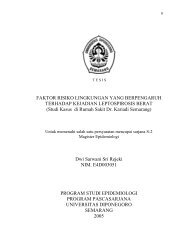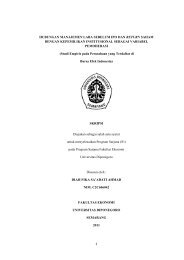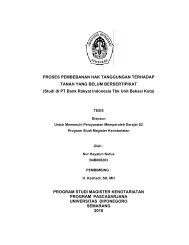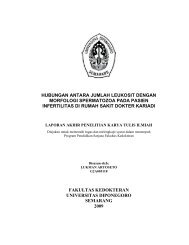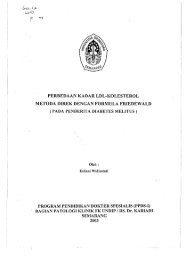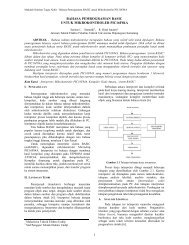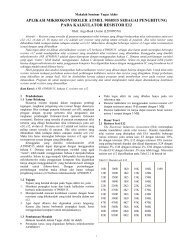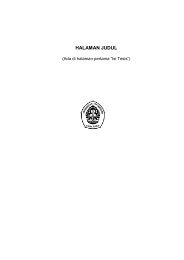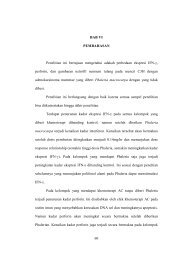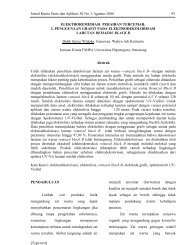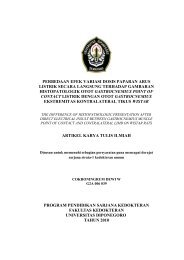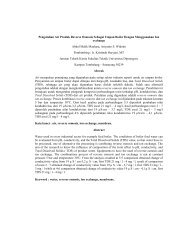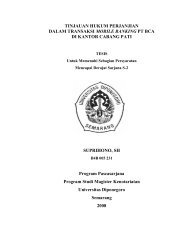Organizing Knowledge in Implementation of Knowledge ...
Organizing Knowledge in Implementation of Knowledge ...
Organizing Knowledge in Implementation of Knowledge ...
Create successful ePaper yourself
Turn your PDF publications into a flip-book with our unique Google optimized e-Paper software.
Proceed<strong>in</strong>gs <strong>of</strong> The 1 st International Conference on Information Systems For Bus<strong>in</strong>ess Competitiveness (ICISBC) 2011<br />
3. Socializ<strong>in</strong>g and sell<strong>in</strong>g the KM concept and <strong>in</strong>itiative as<br />
well as shar<strong>in</strong>g a vision to senior management.<br />
4. Gett<strong>in</strong>g Buy-<strong>in</strong> and advocacy <strong>of</strong> senior management<br />
5. conduct<strong>in</strong>g mentor<strong>in</strong>g KM <strong>in</strong>itiatives to senior<br />
management and other parties.<br />
6. Deliver<strong>in</strong>g the benefits <strong>of</strong> KM that contributes<br />
significantly to the success <strong>of</strong> the company. (Leitch &<br />
Rosen, 2001)<br />
In l<strong>in</strong>e with the op<strong>in</strong>ion Leicth & Rosen, Tiwana (2000)<br />
added the duties <strong>of</strong> a CKO, namely:<br />
Optimiz<strong>in</strong>g the design process for KM.<br />
1) Creat<strong>in</strong>g the canals to optimize knowledge and<br />
competence held by the company.<br />
2) Integrat<strong>in</strong>g knowledge <strong>of</strong> the company's activities and<br />
rout<strong>in</strong>e tasks.<br />
3) Break<strong>in</strong>g down the barriers <strong>of</strong> technique, culture and<br />
flow <strong>of</strong> work <strong>in</strong> communicat<strong>in</strong>g and exchang<strong>in</strong>g <strong>of</strong><br />
knowledge.<br />
4) Ensur<strong>in</strong>g that the company learned from the mistakes <strong>of</strong><br />
the past.<br />
5) Creat<strong>in</strong>g value which is produced by f<strong>in</strong>ancial and<br />
nonf<strong>in</strong>ancial knowledge assets and KM tools<br />
6) Support the completion <strong>of</strong> the tasks above to bridge the<br />
gap <strong>of</strong> <strong>in</strong>formation technology and knowledge flow.<br />
As stated by Pace & Faules that:<br />
"Humans be<strong>in</strong>g create, ma<strong>in</strong>ta<strong>in</strong>, and decided to<br />
reality through the use <strong>of</strong> symbols. Humans be<strong>in</strong>g do not<br />
just respond and adapt to what's out there. They create the<br />
environment and participate <strong>in</strong> the process <strong>of</strong> social creation.<br />
The great part <strong>of</strong> human be<strong>in</strong>g is challenge is to recognize<br />
and adapt to the social process itself. "(Pace & Faules,<br />
2002:15)<br />
All processes will always face obstacles, <strong>in</strong> order to<br />
overcome this obstacle it is necessary a media to handle it.<br />
This activity is <strong>in</strong>tended to KM processes which have<br />
<strong>in</strong>crease the activity <strong>of</strong> knowledge shar<strong>in</strong>g besides that, the<br />
usage <strong>of</strong> knowledge will also <strong>in</strong>crease the knowledge for<br />
everyone, also for the managers themselves will add new<br />
knowledge when it comes to new problems. So the manager<br />
must always renew the exist<strong>in</strong>g conditions so it will be<br />
always <strong>in</strong> the better condition and resolve problems <strong>in</strong> the<br />
implementation <strong>of</strong> KM <strong>in</strong> the organization. Thus we can<br />
conclude that the KM managers must have specific<br />
characteristics that is active and creative, besides that the<br />
technical capability and the general capability because <strong>of</strong><br />
duties and responsibilities thatare attached to regular work<br />
duties. Nevertheless they should be able to handle any<br />
obstacle that is done with a quick solution to anticipate the<br />
breakdown <strong>of</strong> the communication process between fellow<br />
employees and the company.<br />
III. CLOSING<br />
From the results <strong>of</strong> studies that have been done, so the<br />
conclusion can be drawn as follows:<br />
1. <strong>Knowledge</strong> management which is done by mak<strong>in</strong>g<br />
taxonomy based processes and bus<strong>in</strong>ess operations is<br />
called as knowledge centers that are stored on the<br />
<strong>in</strong>tranet while competency-based stream called virtual<br />
competency center. For other media are managed by a<br />
special unit that is the library. The technology media<br />
support <strong>in</strong>formation and communications <strong>in</strong>tended to<br />
improve <strong>in</strong>formation transfer and shar<strong>in</strong>g <strong>of</strong> knowledge<br />
organization as a whole through cooperation and<br />
communication between <strong>in</strong>dividuals.<br />
2. KM managers have specific characteristics, <strong>in</strong> addition<br />
to hav<strong>in</strong>g technical skills also have the general ability<br />
because <strong>of</strong> the duties and responsibilities that are<br />
attached to regular work duties nevertheless, they are<br />
able to handle any obstacle with a quickly solution to<br />
anticipate the breakdown <strong>of</strong> the communication process<br />
through KM tools.<br />
SUGGESTION<br />
1. It is better to make guidel<strong>in</strong>es <strong>of</strong> writ<strong>in</strong>g articles on KM<br />
Tool, <strong>in</strong> order to avoid a flood <strong>of</strong> <strong>in</strong>formation that is not<br />
need. For example the text have been made by others.<br />
2. It is better also to make the theme <strong>of</strong> writ<strong>in</strong>g, so that the<br />
contributors will more focus <strong>in</strong> creat<strong>in</strong>g the knowledge.<br />
Therefore, it will give deep exploration a theme.<br />
3. Form <strong>of</strong> virtual communication <strong>in</strong> KM should also<br />
explore the tacit knowledge. It is appropriate if the<br />
contributors are also allowed to create works that are<br />
audio-visual format. For example how to use<br />
technology <strong>in</strong> the 3.5 G DAT file format, or how to<br />
assemble the satellite Telkom2.<br />
REFERENCES<br />
[1] Buckman,R.H. 2004. Build<strong>in</strong>g a knowledge-Driven Organization.<br />
Mc.Graw Hill.<br />
[2] Davenport, T. and Prusak, L. (1998) Work<strong>in</strong>g knowledge: how<br />
organizations manage what they know. Cambridge, MA:<br />
Harvard Bus<strong>in</strong>ess School Press<br />
[3] Honeycutt, Jerry.2000. <strong>Knowledge</strong> Management Strategies :<br />
Strategi <strong>Knowledge</strong> management. Jakarta : PT. Alex<br />
Media Komput<strong>in</strong>do<br />
[4] Leonard, D., & Sensiper, S.1969. The Role <strong>of</strong> Tacit <strong>Knowledge</strong><br />
<strong>in</strong> Group Innovation.<br />
[5] Newel, Sue.,Et all. 2002. Manag<strong>in</strong>g knowledge Work. New york:<br />
Palgrave.<br />
[6] Nonaka I & Takeuci, 1995. The knowledge creat<strong>in</strong>g company.,<br />
New York: Oxford University.<br />
[7] Pace, R Wayne dan Faules, Don F. 1989. Organizational<br />
Communication, New Jersey : Prentice Hall<br />
[8] Polanyi,M. 1967. The Tacit dimension. London: Routhledge<br />
& Kegan Paul.<br />
[9] Tapscoot, Don. 1996. The Digital Economy. New York:<br />
Mc.Graw Hill<br />
[10] Tiwana,A. 2001.The essential guide to knowledge<br />
Management New jersey: Prentice hall,<br />
353



